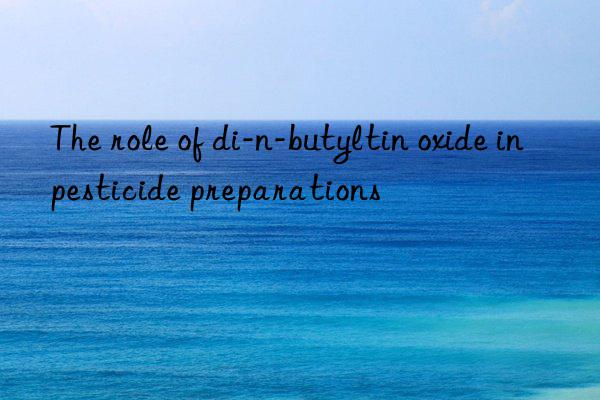
Dibutyltin Oxide (DBTO) is an organic tin compound with the chemical formula (C4H9)2SnO. Although DBTO is primarily used in industry as a catalyst and stabilizer, particularly in the production of polyurethane foams, it is also found in some pesticide formulations as an active ingredient or auxiliary. However, due to their potential effects on the environment and health, the application of organotin compounds is strictly regulated, and their use has been restricted or banned in many countries and regions.
Application of DBTO in pesticide formulations
In the field of pesticides, DBTO and its derivatives have been used as insecticides, fungicides and algaecides. These compounds inhibit or kill a variety of microorganisms, including bacteria, fungi, and certain types of algae. The antibacterial properties of DBTO make it an active ingredient in some pesticide formulations, especially in the control of crop diseases.
For example, DBTO and other organotin compounds have been used to prevent algae growth on ship hulls and to control algal blooms in aquaculture. Additionally, they are used in horticulture and agriculture to prevent plant diseases caused by fungi, such as powdery mildew, rust, and black spot.
Mechanism of action of DBTO
Organotin compounds, including DBTO, often exert their antibacterial effects by interfering with the metabolic processes of microorganisms. They can combine with the thiol groups on the cell membrane of microorganisms, causing damage to the cell membrane, thereby triggering the leakage of intracellular substances and cell death. In addition, they can inhibit the enzyme system of microorganisms and prevent energy production and cell division, thus achieving a bactericidal effect.
Environmental and health considerations
However, organotin compounds, including DBTO, have received widespread attention for their potential negative effects on the environment and human health. Research shows that organotin compounds are highly toxic to aquatic ecosystems and can accumulate in organisms and pass along the food chain, posing a threat to biodiversity. In addition, long-term exposure to organotin compounds can cause damage to human health, including adverse effects on the nervous system, reproductive system, and immune system.
Regulation and substitution
In light of the above concerns, the international community has taken action to restrict or ban the use of organotin compounds in certain areas. The EU’s REACH regulations (Registration, Evaluation, Authorization and Restriction of Chemicals Regulations) strictly restrict the use of DBTO and related organotin compounds, especially prohibiting their use in pesticides. Many other countries are following similar regulations and turning to safer, greener alternatives.
Conclusion
Although di-n-butyltin oxide (DBTO) has been used in pesticide formulations for its effective antibacterial properties, it has Due to potential environmental and health hazards, its use has been significantly restricted. As the global awareness of sustainable agriculture and environmental protection increases, the development of new, low-toxic, and efficient pesticide ingredients has become an industry trend. In the future, the development of pesticides will pay more attention to eco-friendliness and human safety, aiming to create an agricultural environment that not only ensures crop health but also maintains ecological balance. Against this background, the application of organotin compounds such as DBTO in pesticide formulations will gradually decrease, giving way to a new generation of pesticide technology that is more in line with modern environmental protection concepts.
Extended reading:
bismuth neodecanoate/CAS 251-964-6 – Amine Catalysts (newtopchem.com)
stannous neodecanoate catalysts – Amine Catalysts (newtopchem.com)
polyurethane tertiary amine catalyst/Dabco 2039 catalyst – Amine Catalysts (newtopchem.com)
N-Methylmorpholine – morpholine



